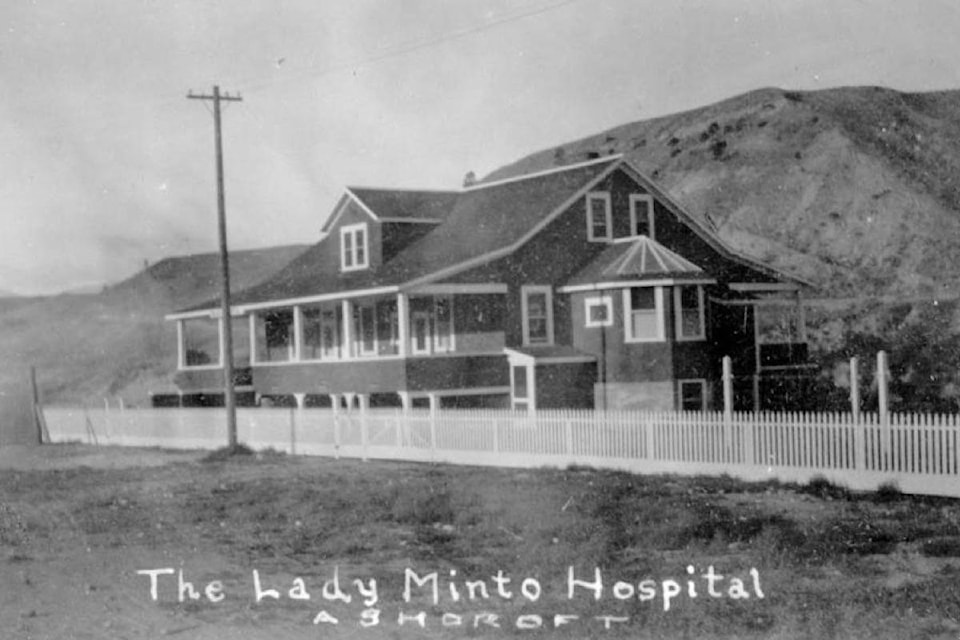Part two of a series about the flu pandemic of 1918 in the southern Interior.
As the flu virus spread throughout October 1918, new cases of influenza were reported in Ashcroft, and a building on the bank of the Thompson River was fitted up to accommodate Chinese patients infected with the virus. The two teachers from the Ashcroft school — which, in common with all other schools in the province, had been closed — were putting their efforts into relief work at the Lady Minto Hospital in Ashcroft, and it was reported that a convention of school trustees slated to take place in Enderby from Nov. 6 to 8 had been postponed indefinitely, “on account of [the] influenza epidemic.”
The Journal of Nov. 9 had shocking news: Dr. Duncan McPhail, who had been working at the Lillooet Hospital for the past two years, had died suddenly. Although the official cause was heart disease, the Journal speculated that McPhail had died from “strain and anxiety brought on by overwork on influenza patients.”
“For the past month, during the influenza epidemic, he has worked night and day having some hundreds of patients to attend to: the strain and anxiety and lack of rest were too much for him, his strength was exhausted, and he passed painlessly away in his sleep … He died at the post of duty, and gave his life for the people. He will be greatly missed and regretted. The heroes are not all in the trenches.”
The death of 141 Mile House resident John Patrick Murphy, aged 53, was the first fatality from the virus recorded in the Journal. The Nov. 16 issue reported that Mrs. H. W. McKenna of Upper Hat Creek had died from influenza at the Lady Minto Hospital in Ashcroft on Nov. 8. She was only 24 years old, and was survived by her husband and three-and-a-half year-old son.
“The death of Mrs. McKenna is one of the saddest that has taken place in the vicinity resulting from the ravage of the influenza epidemic,” noted the paper, showing how rapidly the virus had gone from “not so severe” — as had been reported in October — to something ravaging the area.
On Nov. 18 influenza claimed a prominent victim: 31-year-old Lionel Stobart, who had for several years been the manager of three ranches owned by his uncle (the Gang Ranch at Clinton, the Perry Ranch at Cache Creek, and the Harper Ranch at Kamloops). His work would have brought him into contact with Harold Platt Christie, the government land agent in Ashcroft from 1905 to 1919, and on March 10, 1914 Stobart had married Christie’s daughter Phyllis at St. Alban’s Anglican Church in Ashcroft, just a stone’s throw from the Christie house, which was built in 1905 and still stands at 612 Brink Street.
“Mr. Stobart was in the prime of his life, but was a victim of the influenza which developed to pneumonia,” reported the paper. “When the news of his death was circulated in Ashcroft it was scarcely believable.”
That Stobart was in “the prime of his life” was not uncommon among victims of the Spanish flu. Most influenza strains are hardest on the very young or the very old, but the 1918 pandemic overwhelmingly affected young adults, with 50 per cent of those killed by it aged between 20 and 40. The number of those killed worldwide by the Spanish flu is still debated; best estimates are between 20 and 50 million, although some believe as many as 100 million people succumbed.
However, by mid-November 1918 the tide was turning. On Nov. 23 the Journal reported that “The Ashcroft school, after being closed for three weeks on account of the ‘flu’, opened again last Monday with a fair attendance… The ‘flu’ in Ashcroft and district has abated so much that it is almost safe to say that is has departed to parts unknown. While a great number were more or less infected by the epidemic only a few deaths occurred, and we have that grim reminder of those dark days when it was in almost every house.”
In the Dec. 7 issue of the Journal a letter from Dr. H.A. Hopkins, who had attended many of the Ashcroft and area flu victims, appeared, detailing the many ways in which local people had helped during the epidemic, from opening annexes for influenza patients to preparing meals and assisting with nursing duties. He thanked the citizens of Ashcroft who “so generously offered their services in the nursing and the management of the sick during the last few weeks.”
A week later E.A. Brander, Acting Matron for the Victorian Order of Nurses, wrote to thank those who had helped at the Lady Minto Hospital during the epidemic, noting donations of eggs, milk, honey, apples, and old linen.
“How much we are grateful to the temporary nursing staff, trained and untrained, who worked like veterans old and tried, it is difficult to express, but we shall always feel particularly grateful to Miss Koelkenback and Miss Stephenson who simply did everything without question or hesitation, whether it was attending on the sick, housework, or cooking at a time of great stress.”
The parallels between 1918 and 2020 are many and striking, from the closure of schools and businesses, the run on disinfectants and cleaning supplies, and the cancellation or postponement of many events to the selflessness of health care professionals — who put themselves at risk to treat patients — and the efforts of volunteers to help their communities. It remains to be seen whether or not the COVID-19 pandemic comes and goes relatively quickly, as influenza did in 1918, or stays with us longer. Whatever happens, we can look to the past, realize that this too shall pass, and know that we have a future, however changed it might be.
editorial@accjournal.ca
Like us on Facebook and follow us on Twitter
